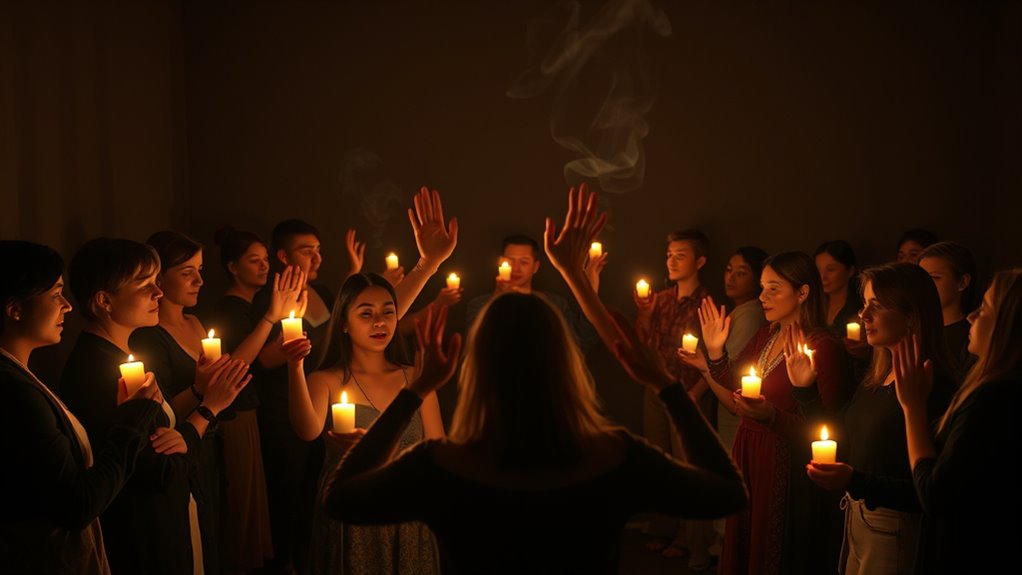Chanting can indeed provide a sense of protection by harnessing the powerful resonance of sound. As you engage in mantra recitation, you’re connecting your spirit to higher dimensions, which can foster emotional healing and strengthen your overall well-being. Many people report transformative experiences and a protective shield against negative energies. The intention behind your chanting plays a vital role in its effectiveness. If you’re curious about specific mantras and practices that can amplify these effects, you’ll find more insights ahead.
Key Takeaways
- Chanting mantras, rooted in historical practices, is believed to create protective energy around individuals and communities.
- Personal experiences show that regular chanting can promote emotional healing and safeguard against negative thoughts.
- Group chanting amplifies protective effects, fostering a sense of interconnectedness and collective support.
- The Mahamrityunjaya Mantra is specifically recognized for its healing and protective qualities, leading to significant benefits for practitioners.
- Mindset and belief in the power of chanting enhance its effectiveness, akin to creating a self-hypnosis effect for personal protection.
The Power of Sound in Buddhism
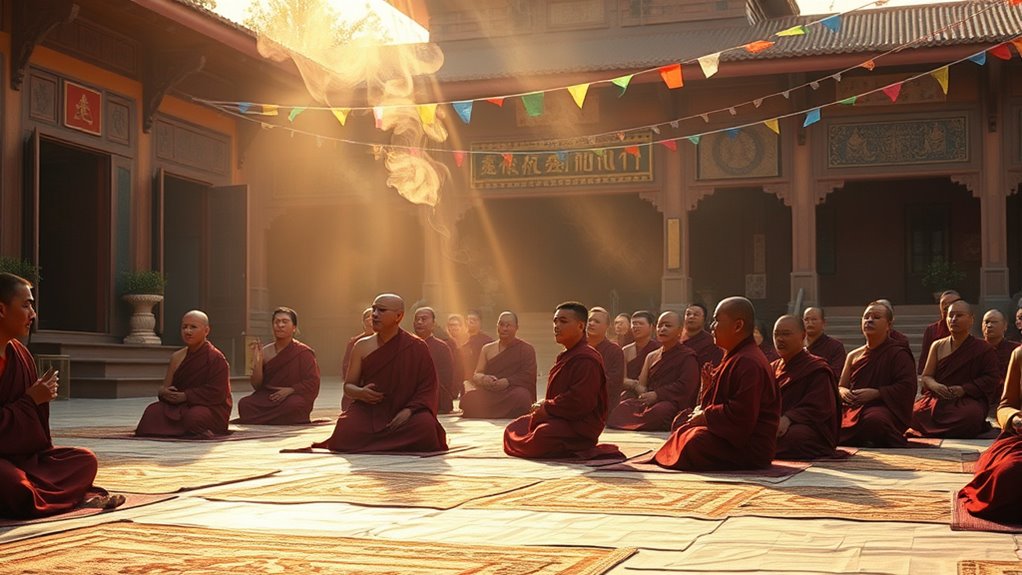
In Buddhism, sound carries profound significance, acting as a bridge between the physical and spiritual realms. You’ll discover the power of mantras as they cleanse emotional energies and connect you to higher dimensions through vibrations.
When you chant, you engage in a rhythmic practice that not only benefits you but also promotes well-being for all living beings. Mantras are divine utterances that hold healing potential, embodying the essence of specific divinities, like Buddhas or Bodhisattvas.
For instance, the Avalokita (Guanyin) illustrates how sound connects with compassion. The Lotus Sutra underscores sound’s impact, suggesting that chanting can help you overcome suffering and achieve abundance.
Even if skeptics dismiss it, the personal nature of mantra chanting makes its effects meaningful for you.
Historical Context of Mantra Chanting

Chanting has deep roots in the history of Buddhism, intertwining with the practices and beliefs of various cultures over centuries.
The first time you explore this tradition, you’ll find:
- The Buddha’s recorded protective recitations, like the Ratana Sutta, aimed at safeguarding disciples.
- Influences from folk traditions, blending magic elements into Theravada Buddhism’s mantra practices.
- Oral traditions that shaped the authenticity of teachings, despite varying interpretations across Buddhist schools.
These elements collectively highlight how chanting evolved, with its historical context grounded in the Buddha’s teachings.
While discrepancies existed in early councils, the acceptance of these texts by different traditions enhances their significance, making the practice of chanting not just a ritual, but a profound link to Buddhism’s rich heritage.
Personal Experiences With Chanting

Many find that personal experiences with chanting can lead to profound transformations. You might discover a sense of interconnectedness and heightened clarity, especially during group sessions.
Initially, you may feel reluctant to engage fully, but overcoming that barrier often releases powerful vocal energy and personal expression. Many practitioners take refuge in the communal aspect, developing emotional connections that enhance their spiritual growth.
Regular chanting can also act as a safeguard against negative thoughts, promoting positive mental patterns and emotional healing. In challenging times, personal anecdotes reveal how chanting provides comfort and relief, suggesting its effectiveness in creating a protective and healing environment.
Benefits of Chanting for Protection

The benefits of chanting for protection extend far beyond mere sound; they resonate deeply within the mind and spirit.
Chanting transcends sound, deeply resonating within the mind and spirit, offering profound protection and transformation.
When you incorporate chanting into your daily routine every morning, you may experience profound transformations:
- Physical wellness: Mantras like the Mahamrityunjaya Mantra are believed to guard against ailments, promoting overall health.
- Emotional connection: Regular chanting fosters a communal experience, enhancing emotional bonds and creating a supportive environment for healing.
- Protective energy: Mantras such as Aad Guray Nameh generate a protective field, offering clarity and a sense of safety.
The Role of Intention in Chanting
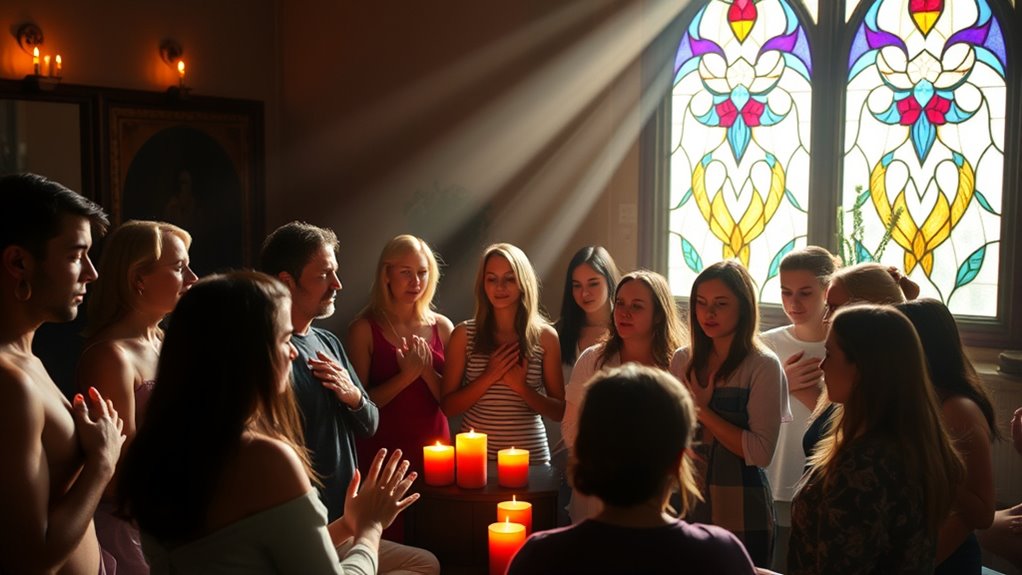
Intention serves as the heartbeat of effective chanting, establishing an essential connection between you and the divine. When you focus your heart and mind on a sincere intention, you amplify that bond, enhancing your overall experience.
The interplay between your verbal and mental repetition deepens your inner feelings and fosters self-connection. As you chant, let your intention act as a catalyst for achieving a pure mind, facilitating contact with higher spiritual dimensions.
The term “mantra” itself suggests its role in protecting the mind, reinforcing that your intention can shape the outcome of your practice. By cultivating genuine intention while chanting, you can unleash transformative experiences and elevate your spiritual awareness.
Community and Tradition in Chanting Practices
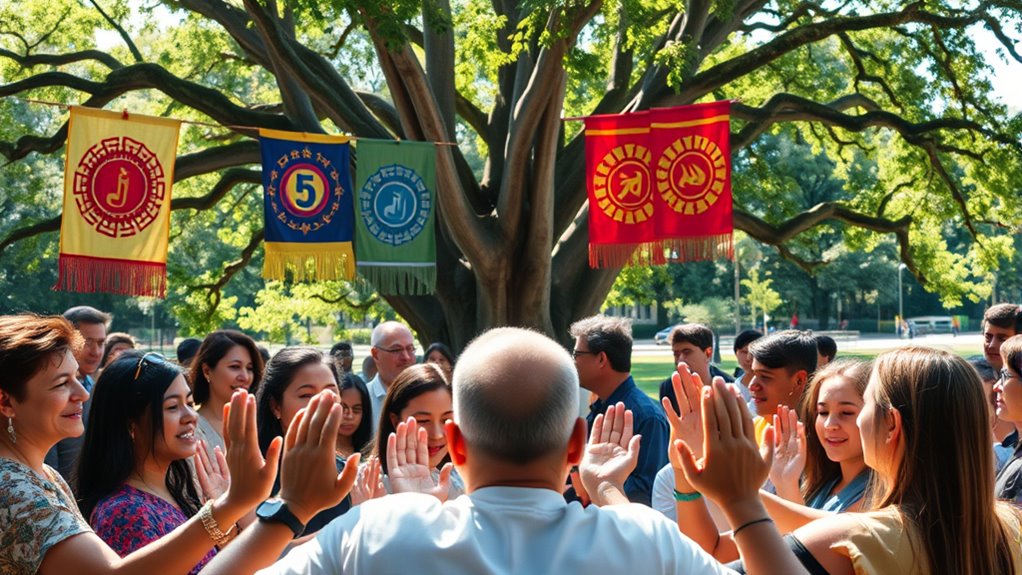
In many Vietnamese Buddhist communities, women play a crucial role in chanting traditions, using these rituals to foster peace and good fortune for their families.
You’ll find that these collective practices not only strengthen social bonds but also reinforce a shared cultural identity.
Women in Chanting Traditions
While chanting traditions often highlight male scholars, women in Vietnam play an essential role in these practices, quietly shaping their communities through their spiritual contributions. They dominate lay Buddhist chanting, often overcoming societal challenges that undervalue their efforts.
Through chanting, these women cultivate:
- A peaceful ambiance that embraces families during rituals
- An empowering connection with their spiritual lineage through common texts
- Strong social bonds in shared spaces filled with tradition and symbolism
Despite facing obstacles, these women maintain their chanting traditions, providing good luck and protection for those they love. The practice, commonly written in significant texts, reinforces collective spirituality and reminds everyone of the importance of their contributions to the spiritual community. Additionally, emotional readiness is vital in fostering strong connections among practitioners, enhancing the overall chanting experience.
Community Bonding Through Chanting
How do community bonds strengthen through the act of chanting? When you participate in chanting rituals, especially within Vietnamese Buddhist traditions, you’re not just vocalizing words; you’re connecting with others.
The shared experience creates an uplifting mood, enhancing your sense of belonging. Women, often leading these chants, empower each other and foster resilience amidst societal challenges. Additionally, the power of curated messages can enhance the emotional connection during these gatherings, allowing participants to express their feelings more profoundly.
As you gather in spaces filled with spiritual symbols, you feel the collective energy of devotion, reinforcing the importance of tradition. This communal practice not only provides peace and good luck for families, but also reinforces spiritual ties among participants.
Ultimately, chanting becomes a powerful tool for bonding, reminding you that together, you can navigate life’s difficulties while honoring your shared heritage. Moreover, sustainable living practices can also be enriched through these community gatherings, as they encourage shared values and collective action towards a more eco-friendly future.
Rituals and Cultural Significance
Chanting rituals hold deep cultural significance in Vietnamese Buddhist communities, where they serve as a bridge connecting individuals to their spiritual heritage.
These practices, often led by women, emphasize spiritual growth and reinforce community ties. As you participate, you might experience:
- The soothing sounds of collective voices resonating in a sacred space.
- Vibrant offerings of incense and flowers, symbolizing devotion and peace.
- The presence of spiritual symbols, creating an atmosphere thick with lineage and tradition.
Through these rituals, practitioners find peace and good luck for their families, highlighting the resilience of women in maintaining these customs.
Engaging in chanting not only strengthens personal spirituality but also fosters social bonds, enriching the cultural fabric of the community.
Spiritual and Energetic Aspects of Mantras
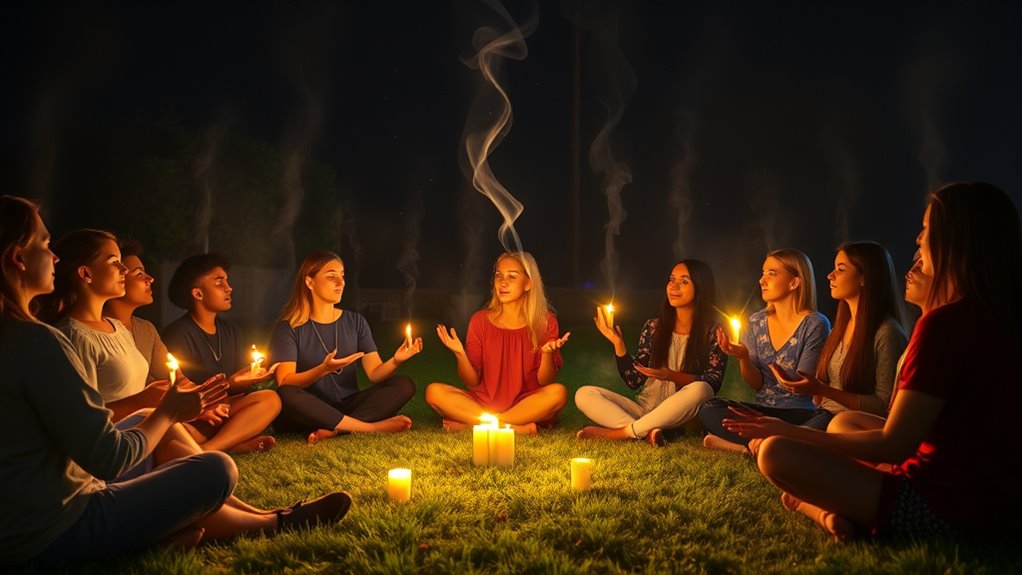
Chanting mantras serves as a powerful tool for spiritual growth, emphasizing sound’s role in meditation. Regular recitation helps protect you from negative influences, fostering inner calmness and peace. Establishing clear rules for children can similarly create a sense of stability in your life. Additionally, the practice of mantra chanting aligns with the concept of spiritual awakening as it encourages a deeper connection to your higher self. Engaging in mantra chanting can also serve as a means of addressing emotional needs that may arise in various aspects of your life.
Chanting mantras is a potent means of spiritual growth, cultivating peace and shielding against negativity through sound.
Around the world, practitioners engage in mantra chanting, creating a spiritual atmosphere that attracts benevolent energies. Even if you don’t fully grasp their meanings, this practice can lead to significant personal transformation and heightened awareness. The use of spiritual alchemy symbols during chanting can further enrich your practice by representing the transformation you seek.
When done in a group, the presence of an audience amplifies the energetic environment, enhancing protective effects and deepening connections among participants. Additionally, exploring chakra balancing methods can further harmonize your energy centers during these chanting sessions.
Embrace this transformative journey for a more profound meditative experience.
Perspectives on Efficacy and Belief

What makes chanting such a powerful tool for so many people? The answer often lies in personal belief and mindset.
When you engage in chanting, you might experience:
- A surge of calm, washing over you like a gentle wave.
- An uplifting energy that feels like a warm embrace.
- A shift in perception, akin to stepping into a new light.
Your intention behind the chant speaks volumes, as a pure heart can deepen your spiritual connection.
Many users report varying levels of comfort and relief, suggesting that belief enhances the perceived power of the practice.
While scientific validation for physical protection may be lacking, the anecdotal evidence of mindset alteration mirrors the effects of self-hypnosis, making chanting a profound experience for many.
The Mahamrityunjaya Mantra: A Case Study
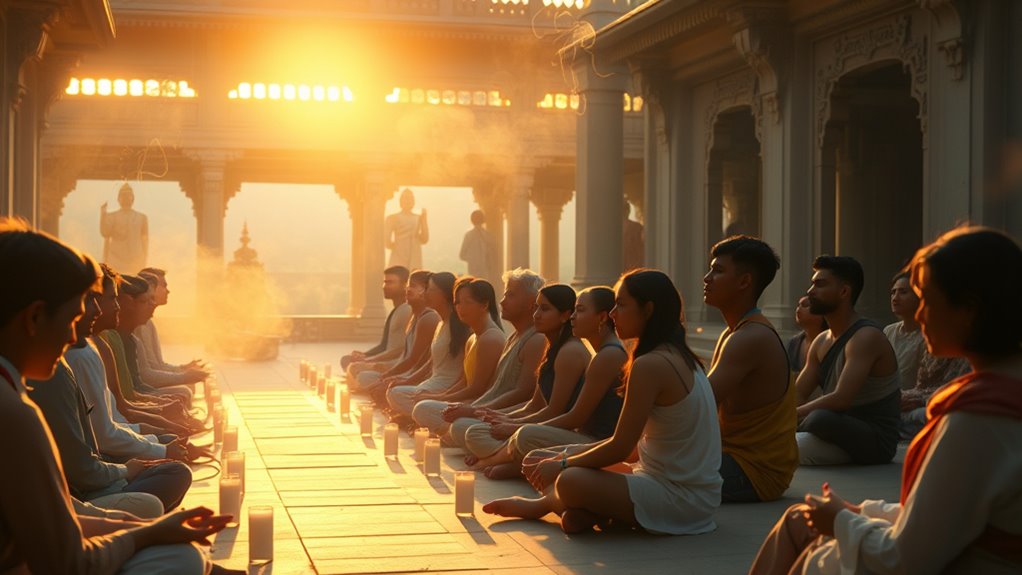
Though many mantras exist within spiritual practices, the Mahamrityunjaya Mantra stands out for its profound healing and protective qualities associated with Lord Shiva.
When you began chanting this mantra daily, especially over 40 days, you might notice significant healing benefits and transformative experiences. Studies on low light office plants suggest that creating a calming environment can enhance focus during meditation, making it easier to connect with the mantra’s energy. Engaging in wellness retreats can further amplify your meditation practice, providing a serene backdrop for deeper exploration, as this aligns with the importance of establishing clear, achievable goals in personal development. Furthermore, integrating family support into your routine can bolster your resilience as you navigate caregiving challenges.
Participants at weekly ashram gatherings enhance its collective potency, creating a supportive atmosphere for everyone involved.
Many individuals have reported miraculous outcomes, feeling the mantra serves as a balm for illness and promoting life-force energy.
As you integrate the Mahamrityunjaya Mantra into your daily life, you invite divine support in personal and relational matters, awakening your consciousness from lethargy or fear.
This powerful practice can profoundly impact your spiritual and physical well-being. Additionally, participants often find that engaging in support networks further enhances their healing journey and connection to the mantra’s energy.
Frequently Asked Questions
Does Chanting Really Work?
Chanting can be a powerful practice for you, but its effectiveness often depends on your belief and intention.
When you engage sincerely, you may find a deeper sense of peace and connection. Many people report feeling transformed and more centered through regular chanting, experiencing benefits like mental clarity and emotional relief.
While skeptics may question its physical effects, your personal experience could reveal positive changes in your overall well-being.
What Happens to Your Body When You Chant?
Imagine standing on a serene shore, each wave of sound washing over you as you chant.
When you chant, your body tunes into these vibrations, awakening your nervous system and energizing your spirit. You might feel a shift in your mood, as the rhythm creates a gentle embrace, fostering calmness and clarity.
As you engage in this practice, you’re not just speaking words; you’re weaving a protective cocoon of tranquility around yourself.
What Are the Powers of Chanting?
Chanting holds incredible powers that can transform your mental and emotional state. When you chant, you create a vibrational energy that enhances your clarity and stability.
This practice connects you with deeper spiritual energies, promoting healing not just for yourself, but also for others. Regularly engaging in chanting strengthens your vigor, minimizes confusion, and helps you fend off negative thoughts.
Why Is Chant so Powerful?
You might’ve noticed how a simple sound can shift your mood or energy.
Chanting is powerful because it taps into the sacred nature of sound, allowing you to connect deeply with your emotions and spiritual energy.
When you chant, you’re not just repeating words; you’re embodying their essence, enhancing your mental clarity and emotional well-being.
Plus, when done in a group, the collective energy amplifies this power, creating a profound shared experience.
Conclusion
In the end, chanting for protection isn’t just about the sound; it’s like opening a hidden door to your inner strength. Whether you find solace in the hum of ancient mantras or the shared energy of a community, your intention fuels the magic. Much like Odysseus steering the seas, you chart your course toward safety and peace. So, embrace the power of your voice, and who knows? You might just discover a shield of harmony surrounding you.
